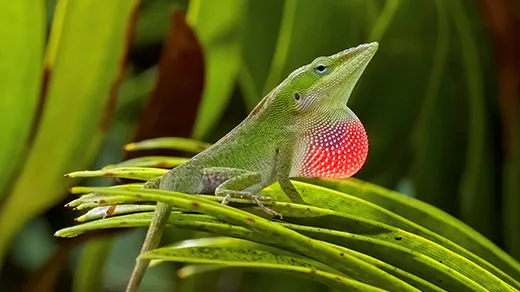Why does natural selection appear to happen slowly on long timescales and quickly on short ones? A multigenerational study of four lizard species addresses biology’s “paradox of stasis.”

The green anole (Anolis carolinensis), native to the United States, was one of four key lizard species in a recent study on stabilizing selection.
Day’s Edge Productions
Introduction
James Stroud had a problem. The evolutionary biologist had spent several years studying lizards on a small island in Miami. These Anolis lizards had looked the same for millennia; they had apparently evolved very little in all that time. Logic told Stroud that if evolution had favored the same traits over millions of years, then he should expect to see little to no change over a single generation.
Except that’s not what he found. Instead of stability, Stroud saw variability. One season, shorter-legged anoles survived better than the others. The next season, those with larger heads might have an advantage.
“I was confused. I didn’t know what was going on. I thought I was doing something wrong,” said Stroud, who was then completing a postdoc at Washington University in St. Louis. “Then it suddenly all fell into place and started to make sense.”
His data reflected a paradox that had stymied biologists for years. In the long term, the anoles had traits that appeared to stay the same, a phenomenon called stasis — presumably caused by stabilizing selection, a process which favors moderate traits. However, over the short term, the lizards showed variation, with fluctuating traits. Stroud’s data was better explained by directional selection, which sometimes favors extreme traits that lead evolution in a new direction, and other times doesn’t appear to favor anything in particular.
Because he had followed four species for three generations, he was able to show that a long-term pattern of stasis could emerge from such short-term fluctuating selection.
“There’s lots of noise, but overall, it leads to fairly stable patterns,” said Stroud, who now runs his own lab at the Georgia Institute of Technology. The study was recently published in the Proceedings of the National Academy of Sciences.
Stroud and his colleagues’ work explains how short-term variability can lead to long-term stability, said Arthur Porto, an evolutionary biologist at the Florida Museum of Natural History who was not involved in the new research.

At Miami’s Fairchild Tropical Botanic Garden live Anolis lizards, which occupy distinct ecological niches on trees. Clockwise from top left: The bark anole (Anolis distichus), a trunk specialist; the green anole (Anolis carolinensis), a low-canopy specialist; the brown anole (Anolis sagrei), a ground specialist; and the knight anole (Anolis equestris), a high-canopy specialist.
Jon Suh
Introduction
“It demonstrates that we can obtain a pattern that resembles stabilizing selection, even when no stabilizing selection appears at a per-generation timescale,” Porto said. The findings help resolve what some frustrated biologists call “the paradox of stasis.”
Evolution’s Steady Hand?
When early evolutionary theorists conceived of natural selection, they reckoned that the evolutionary process works gradually over vast epochs. Species don’t evolve overnight; they largely stay the same and accumulate changes over many generations. In 1859, Charles Darwin wrote: “We see nothing of these slow changes in progress, until the hand of time has marked the long lapse of ages.”
Early observations of the fossil record supported this idea. Often, paleontologists uncovered evidence that a species could remain stagnant over millions of years, only changing when forced to adapt to some dramatic environmental shift. Most of the time, though, the process of evolution seemed achingly slow, the biological equivalent of watching paint dry.
Biologists explained this inertia as the product of stabilizing selection, in which average or intermediate traits are consistently favored over more extreme ones. Even small shifts away from “average” would be accompanied by a steep drop in survival or fertility.
A classic example of stabilizing selection comes from historic records of human birth weights, said Jonathan Losos, an evolutionary biologist at Washington University in St. Louis and Stroud’s research adviser. Compilations of birth-weight data in the mid-20th century showed that babies of average weight survived more often than those that were heavier or lighter than average.
“Long-term stasis seems to suggest stabilizing selection,” Losos said. “It’s the most favored explanation.”
It wasn’t until the early 1980s that scientists developed methods that could test this idea. In 1983, the biologists Russell Lande and Stevan Arnold brought advanced statistics to evolutionary field studies, showing in a landmark Evolution paper how researchers could measure the impact of natural selection within a single generation. The approach, which quantified selection on groups of correlated traits, required biological data sets that were very large, especially by the standards of the 1980s. Still, it was the first statistical framework to show researchers how to measure different kinds of natural selection, including stabilizing selection, on multiple traits, said Christopher Martin, an evolutionary biologist at the University of California, Berkeley.

For his multiyear study on stabilizing selection, James Stroud captured 1,692 individuals of four Anolis lizard species using a tiny lasso (left), then transported each in a plastic bag (bottom right) to a field station (top right) to collect data on traits, including weight, leg length and head size.
Day’s Edge Productions
Introduction
Evolutionary biologists rapidly adopted the approach. Princeton University’s Rosemary and Peter Grant used the method in their celebrated studies of Darwin’s finches on the island of Daphne Major in the Galápagos. Their study, which began in 1973 and continues to this day, followed a population of the medium ground finch (Geospiza fortis) through a severe drought that began in 1977. That’s when the plants of Daphne Major stopped producing the small seeds on which the birds relied; only thick seeds remained.
With little food, the finch population plummeted from 1,400 individuals to a few hundred in only two years. Then the Grants watched the population recover while taking careful measurements of the birds’ traits. The birds that survived, they found, had larger beaks suited to the larger seeds: The average beak depth had increased from 9.2 mm to 9.9 mm — a change of more than 7%.
All told, a shift in annual rainfall had rapidly resulted in a change in the birds’ beaks. The Grants’ work became a classic example of evolution in action. They had identified marked, if often subtle, evidence of the directional push and pull of evolution acting on traits. And they weren’t alone: Once researchers had the statistical tools to watch evolution unfold, it seemed that everywhere they looked, they could see natural selection acting within very short intervals.
Such studies challenged the idea that evolution proceeded through slow, imperceptible changes over vast time spans, said Matt Pennell, an evolutionary biologist at the University of Southern California. Change could — and did — happen quickly.
Therein lay the problem. With enough time, even the tiniest tugs should yield a measurable shift in an organism’s observable characteristics. If the beak-size changes the Grants observed continued over millennia, back-of-the-envelope calculations predicted some extreme phenomena, Pennell said. “You’d expect finches that were, like, 40 kilograms. This just makes no sense.”
What’s more, as the evidence for directional selection piled up, little proof emerged on the side of stabilizing selection. The fossil record clearly showed stasis in traits over time. But with their new statistical tools, evolutionary biologists couldn’t find evidence for a mechanism that would produce stasis.
The evidence for both short-term modification and long-term stability was sound. What biologists couldn’t figure out was how to link the two phenomena in a way that could resolve this paradox of stasis.
An explanation, it turned out, was waiting among the trees of South Florida.
An Anole Oasis
The turquoise waters and white sands of the Caribbean aren’t paradise for just humans. Anole lizards have also found these tropical isles to be idyllic havens. The lizards have spread across the Caribbean through a process called adaptive radiation. When a species of anole arrived on a new island, it rapidly evolved into several new species, each of which took advantage of a different habitat.
“There seems to be a mismatch between microevolutionary processes and what’s going on with longer timescales,” said Kjetil Lysne Voje, an evolutionary biologist at the Natural History Museum at the University of Oslo.

The first Anolis lizard to arrive on a Caribbean island evolved, over millions of years, into multiple species that fill the same ecological niches, including high canopy (left), low canopy (middle), ground (right) and trunk. The lizards on a given island are more closely related to each other than to their respective ecomorphs on other islands.
Jon Suh and Day’s Edge Productions
Introduction
Over and over again, on island after island, the anoles evolved to fill different niches, gaining characteristic sets of traits to help their survival in their preferred habitat. One species kept long legs — ideal for sprinting — and small, sticky toe pads more often planted on terra firma. Three others scampered up tree trunks: a small-bodied species that preferred the lower half of the trunk, one that ventured into the low canopy on large toe pads, and one that favored the high canopy, evolving short limbs to expertly navigate thin branches.
After that initial burst of evolution, the lizards remained virtually identical over millions of years. And that’s how Losos found them when he began studying the reptiles in the 1980s.
“The different types seem to have evolved a long time ago, and then stuck there,” Losos said. “Presumably they’ve been like that ever since.”
The anoles’ ability to colonize new land made them well suited to becoming invasive species. In Florida, the native North American green anole (Anolis carolinensis) has lived high up on tree trunks, consuming arboreal insects in the low canopy, for millions of years. Over the past century, however, other anoles have arrived in the state from Cuba, Hispaniola and the Bahamas. The brown anole (Anolis sagrei) dwells on lowermost tree trunks, using its long legs to jump onto the ground to hunt insects. The small-bodied bark anole (Anolis distichus) eats ants crawling along trunks, while the larger knight anole (Anolis equestris) pursues insects and fruit in the upper canopy. Each species had already adapted to its specific niche before arriving in Miami. Their ecology persisted in their new home.
As a lizard enthusiast, Stroud wanted to study his adopted city’s herpetological smorgasbord. To conduct a long-term field study, however, he would need to track the anoles over time. The high mobility of the lizards posed a major problem. If he lost track of an individual, he wouldn’t know whether it had moved out of the area or died. Just as frustrating, he wouldn’t be able to tell if new arrivals were the offspring of existing lizards or new immigrants.
After scouring the city for sites, he realized that the location of Miami’s Fairchild Tropical Botanic Garden made it an ideal study spot because the anoles were effectively trapped on the ersatz island. He could be confident that no lizards had arrived or left.
Stroud’s goal was to measure natural selection operating over several generations in multiple species. He wanted to “catch lots of lizards and measure them and see if their survival told us anything about how evolution occurs in the wild,” he said.
He spent three years taking a variety of measures of body shape and size from the four anoles that call the botanic garden home — 1,692 individuals in total. To gather thousands of data points on leg length, head size and overall survival, Stroud had to capture each lizard using a tiny lasso and then set to work with calipers before injecting a tiny microchip under its skin. The microchip ensured that he could keep track of each individual anole. If he couldn’t detect a tracker, he knew the anole had likely died.
“This type of work is hard enough to do in one species. So to execute a project like this in four species is really exceptional,” said Jill Anderson, an evolutionary biologist at the University of Georgia who was not involved in the research.
When Stroud began analyzing his data, however, he ran smack into the paradox of stasis.
Stasis in the Noise
From the beginning of the project, Stroud and his colleagues were interested in stabilizing selection. They wanted to see if the forces of natural selection continually pushed and pulled the lizards’ traits to keep them centered on the same point. That the anoles had shown little evolutionary change over millions of years indicated that they were on some sort of evolutionary peak, and Stroud wanted to see what factors kept them there.
However, his years of data didn’t show stability at all. Instead, he saw evolution constantly shifting the traits that were best adapted to the environment. “If we look at any one period on its own, we very rarely see stabilizing selection,” Stroud said.

James Stroud and his colleagues took detailed data on many traits, including toe-pad size. To measure the lizards’ tiny toe pads, their feet were pressed onto clear plastic (left) and then the toepads were photographed from the other side (right). Measurements were then derived from the photograph.
Day’s Edge Productions
Introduction
Over time, however, that variability averaged out into stasis. Even if traits wobbled off their optimal, moderate peak from one generation to the next, there was a net effect of stabilization — ultimately leading to little change over the multiple generations.
Experts who reviewed Stroud and his team’s data were impressed by its thoroughness and its ability to resolve the seeming paradox. “The data are more beautiful than anyone could reasonably even hope doing a study like this,” Martin said.
Anderson said that Stroud’s “super cool” work was able to address one of biology’s biggest mysteries because of his thoughtful and rigorous study design. Only with many years’ worth of data, she said, could Stroud see how stasis could potentially emerge out of such variability.
Voje also offered praise: “This is an excellent example of work that ties some of these observations together,” he said.
Jeffrey Conner, a botanist and evolutionary biologist at Michigan State University, agreed that the conceptual framework Stroud developed can explain stabilizing selection. However, he said that the variability in directional selection Stroud identified was fairly minimal.
Still, recent research from other labs also helps to support Stroud’s results. A study published in Evolution in September 2023 from the lab of Andrew Hendry, an eco-evolutionary biologist at McGill University, studied evolutionary changes in a community of finches on the Galápagos island of Santa Cruz over 17 years. There, too, Hendry found evidence of natural selection’s regular tug of war on traits that was embedded within a “remarkable stability,” he said, of the finches over evolutionary time.
To Hendry, the paradox of stasis was never a paradox at all. The issue, he said, was that biologists assumed that long-term stasis was the result of short-term stability. Throw out that assumption, and the paradox disappears. “The paradox is illusory,” he said. “Evolutionary biologists like to come up with things and call them paradoxes.”
Think of it more like the Mississippi River before it was engineered, he explained. It rapidly shifted course in small areas over short periods, and yet for tens of millions of years the river’s overall journey led to the Gulf of Mexico. Similarly, a lizard population’s traits can vary over the short term and stay stable over the long haul.
Still, three years — or 17 — are a drop in the bucket of evolutionary time. Fully resolving the paradox will require scientists to study time spans between macro- and microevolution, Porto said — on the scale of tens, hundreds or thousands of years. They need to find a sweet spot that is long enough to allow both change and stasis to emerge, he said, although at the moment biologists don’t have a long enough data set to draw from.
That’s why long-term field studies in ecology and evolutionary biology are increasingly critical, Stroud said. Without returning to his study site again and again over a period of years, he never would have obtained enough data to address one of the key hypotheses of evolutionary biology.
Quanta is conducting a series of surveys to better serve our audience. Take our biology reader survey and you will be entered to win free Quanta merchandise.
Next article
The Year in Math
>>> Read full article>>>
Copyright for syndicated content belongs to the linked Source : Quanta Magazine – https://www.quantamagazine.org/evolution-fast-or-slow-lizards-help-resolve-a-paradox-20240102/































